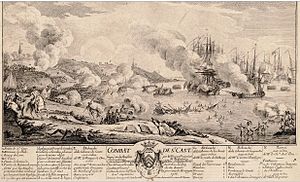
Back معركة القديس كاست Arabic Schlacht bei Saint-Cast German Batalla de Saint-Cast Spanish Bataille de Saint-Cast French サン=カスの戦い Japanese 생 카스 전투 Korean Slaget ved Saint Cast NN Batalha de Saint Cast Portuguese 聖卡戰役 Chinese
| Battle of Saint-Cast | |||||||
|---|---|---|---|---|---|---|---|
| Part of the Seven Years' War | |||||||
 Engraving by Nicolas Ozanne | |||||||
| |||||||
| Belligerents | |||||||
|
|
| ||||||
| Commanders and leaders | |||||||
|
|
| ||||||
| Strength | |||||||
| 10,000 | 8,000-9,000 soldiers and militiamen[2] | ||||||
| Casualties and losses | |||||||
|
2,300 killed or wounded[3][4] 800 prisoners[5] | 300 | ||||||
The Battle of Saint-Cast was a military engagement during the Seven Years' War on the French coast between British naval and land expeditionary forces and French coastal defence forces. Fought on 11 September 1758, it was won by the French.
During the Seven Years' War, Britain mounted numerous amphibious expeditions against France and French possessions around the world. In 1758 a number of expeditions, then called descents, were made against the northern coast of France. The military objectives of the descents were to capture and destroy French ports, divert French land forces from Germany, and suppress privateers operating from the French coast. The battle of Saint-Cast was the final engagement of a descent in force that ended in a French victory.
- ^
- "...the standard of France was white, sprinkled with golden fleur de lis..." (Ripley & Dana 1879, p. 250).
- On the reverse of this plate it says: "Le pavillon royal était véritablement le drapeau national au dix-huitième siecle...Vue du chateau d'arrière d'un vaisseau de guerre de haut rang portant le pavillon royal (blanc, avec les armes de France)" (Vinkhuijzen collection 2011).
- "The oriflamme and the Chape de St Martin were succeeded at the end of the 16th century, when Henry III., the last of the house of Valois, came to the throne, by the white standard powdered with fleurs-de-lis. This in turn gave place to the famous tricolour" (Chisholm 1911, p. 460).
- ^ Revue anglo-française, Tome Quatrième, Poitiers, 1836, pp. 45–46
- ^ Revue anglo-française, Tome Quatrième, Poitiers, 1836, p. 47, " De trois mille hommes qui restaient encore à terre losque l'action commença, la moitié trouva la mort sur la champ de bataille, huit cents se noyèrent, sept cents furent faits prisonniers: pas seul ne rejoignit la flotte." – "Of 3000 men ashore at the start of the action.... half found their death on the battlefield, 800 drowned and 700 were taken prisoner: not a single one rejoined the fleet."
- ^ A soldier's journal containing a particular description of the several descents on the coast of France last war; with an entertaining account of the islands of Guadaloupe Dominique, &c. and also of the isles of Wight and Jersey. To which are annexed, Observations on the present state of the army of Great Britain., London, Printed for E. and C. Dilly, 1770, p. 40, "are more valuable to some than the lives of eight hundred grenadiers."
- ^ Accounts vary of the number of prisoners from 400–800 including four named sea captains, the earliest French count mentioned in the Origins and services of the Coldstream Guards is 639 and Smollett in History of England, Vol III, p. 503 mentions that the French provide a list of the prisoners and mentions the four sea captains, as does Barrow in Life of George, Lord Anson, while other French accounts mention a very specific 732 prisoners which may be drawn from the list.
© MMXXIII Rich X Search. We shall prevail. All rights reserved. Rich X Search